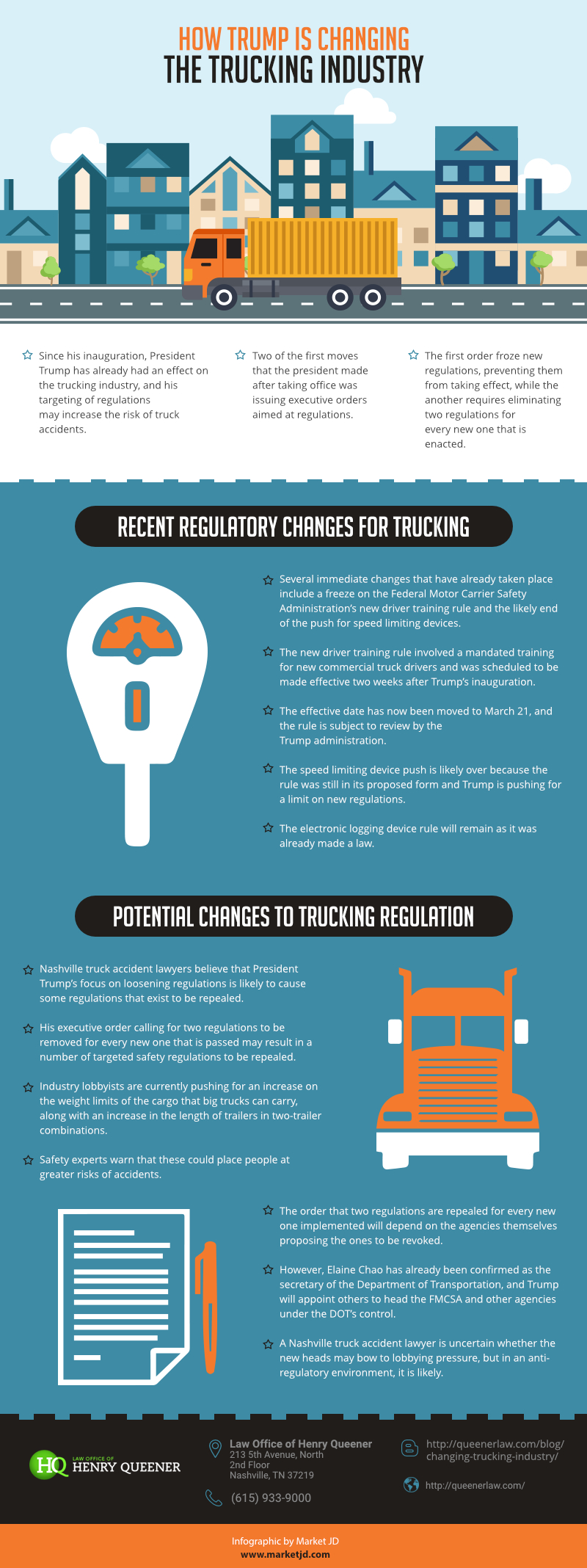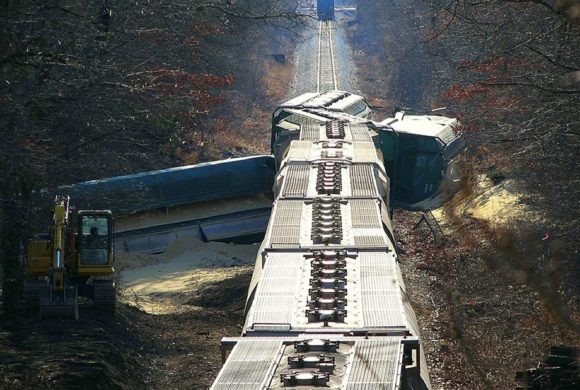
by Queener Law | Jan 12, 2017 | Colorado, Kentucky, Tennessee, Trucking Accident
A variety of large truck trends are evolving the trucking industry and will likely reshape the way transportation of products occurs in the future. With more than 3.5 million truck drivers transporting almost 70 percent of all freight in the United States, these trends are expected to have a significant impact throughout the nation.
Trucking Industry Trends
There are a number of new regulations and trends that the general public and trucking accident attorneys as well as truck drivers and trucking companies should be aware of. Some of the most important include:
More Efficient Technology
Advances in technology could mean less large truck traffic for 2017. As new technologies gain popularity in the trucking industry, many truckers across the nation will begin to experience an entirely new way of life. Global Positioning Systems (GPS) will help ensure that drivers use the quickest, most efficient routes when making their deliveries, for example. Software that sorts and analyzes freight, drop-off and pick-up locations and times, and loads will make combining shipments more efficient and could potentially reduce the number of large trucks on the road.
Electronic Logging Devices
As of December 16, 2017, truckers nationwide will be required to use electronic logging devices (ELDs). These devices are designed to ensure that commercial drivers are in compliance with hours of service (HOS) regulations that reduce the risk for driver fatigue. Until recently, drivers were only required to log their hours on paper, often resulting in falsification and inaccuracy. The implementation of ELDs is expected to ensure that drivers’ logs are more accurate and that law enforcement officials can more efficiently review driver activity. Additionally, the reduction of paper logs is predicted to provide more than $1,000,000 in additional revenue. Many small- and medium-sized carriers, however, say that the ELD mandate will cost them as much as 5 to 8 percent in lost productivity. The cost of installing approved ELDs is also likely be financially burdensome for smaller companies.
Government Regulations on Trucking
A host of new government regulations are expected to shake up the trucking industry in 2017 and beyond. One change that is anticipated is a national truck driver drug testing information clearinghouse with hair-follicle drug testing. Since these tests will likely disqualify a large number of drivers due to positive results, many truck drivers’ unions are in protest of this change. Additionally, carbon emissions and other environmental regulations are expected.
Autonomous Trucks
Truck driver shortage has been a problem that has plagued the United States for many years, and autonomous trucks just might be the answer. In 2016, Uber sent a Budweiser beer shipment from Fort Collins to Colorado Springs by way of an autonomous truck, and various manufacturers across the globe are currently testing this new technology.
Truck Driver Shortage
As a number of truck drivers approach retirement age in 2017, the shortage of truckers is only expected to increase. And since trucking companies report that most of their applicants are not qualified to drive a commercial truck, there seems to be no end to the shortage in sight. Unfortunately, a lack of drivers will raise the risk for large truck crashes due to trucker inexperience, driver fatigue, and rushed deliveries.
Trump’s Impact on the Trucking Industry
With Donald Trump now officially the President of the United States, a number of changes are on the horizon that are expected to have a significant impact on the trucking industry. If he follows through on his plans to possibly end certain trade agreements like the North America Free Trade Agreement (NAFTA) and the Trans Pacific Partnership (TPP), the large amount of domestic freight that comes from trade activity and is typically hauled over the road could be reduced.
The Effect of Trucking Trends on Accidents
Although the number of injury crashes has decreased over the past year, the number of fatality crashes has increased by about one hundred. It is hoped that the new trucking industry regulations, advances in technology and increased efficiency in transportation practices will reduce the number of serious injuries and fatalities that occur.
According to the Federal Motor Carrier Safety Administration (FMCSA), large trucks are involved in approximately 87,000 injury crashes and about 4,000 fatality accidents every year. Trucking accident attorneys in Tennessee typically see numerous victims throughout their careers with severe injuries resulting from large truck crashes. When individuals are injured or killed in large truck crashes, truck drivers, trucking companies, and even manufacturers can sometimes be held liable. When the crash is the fault of the driver or defective equipment, victims and their families can recover damages for medical costs, pain and suffering and lost wages.

by Queener Law | Jan 12, 2017 | Colorado, Kentucky, Tennessee, Trucking Accident
Since his inauguration, President Trump has already had an effect on the trucking industry, and his targeting of regulations may increase the risk of truck accidents. Two of the first moves that the president made after taking office was issuing executive orders aimed at regulations. The first froze new regulations, preventing them from taking effect, while the other requires eliminating two regulations for every new one that is enacted.
Recent Regulatory Changes for Trucking
Several immediate changes that have already taken place include a freeze on the Federal Motor Carrier Safety Administration’s new driver training rule and the likely end of the push for speed limiting devices. The new driver training rule involved a mandated training for new commercial truck drivers and was scheduled to be made effective two weeks after Trump’s inauguration. The effective date has now been moved to March 21, and the rule is subject to review by the Trump administration. The speed limiting device push is likely over because the rule was still in its proposed form and Trump is pushing for a limit on new regulations. The electronic logging device rule will remain as it was already made a law.
Potential Changes to Trucking Regulation
Nashville truck accident lawyers believe that President Trump’s focus on loosening regulations is likely to cause some regulations that exist to be repealed. His executive order calling for two regulations to be removed for every new one that is passed may result in a number of targeted safety regulations to be repealed. Industry lobbyists are currently pushing for an increase on the weight limits of the cargo that big trucks can carry, along with an increase in the length of trailers in two-trailer combinations. Safety experts warn that these could place people at greater risks of accidents.
The order that two regulations are repealed for every new one implemented will depend on the agencies themselves proposing the ones to be revoked. However, Elaine Chao has already been confirmed as the secretary of the Department of Transportation, and Trump will appoint others to head the FMCSA and other agencies under the DOT’s control. A Nashville truck accident lawyer is uncertain whether the new heads may bow to lobbying pressure, but in an anti-regulatory environment, it is likely.

by Queener Law | Dec 29, 2016 | Colorado, Kentucky, Tennessee, Trucking Accident
There are four “no-zones” that surround semi-trucks. A no-zone is an area around a semi-truck wherein most accidents occur. According to the National Highway Traffic Safety Administration (NHTSA), 71 percent of fatal collisions involving two or more vehicles, including a truck, are caused by the other vehicle. Thus, many accidents involving semi-trucks are preventable if passenger vehicles safely share the road.
No-Zones
The no-zone is typified in two situations. First, it is an area around the truck in which the truck driver suffers from reduced visibility (in passenger cars these are called “blind-spots”). Second, it is a zone near the truck in which maneuverability is reduced therefore the truck driver lacks the same timeframe to react as a passenger car.
Blind-spots
Semi-trucks are surrounded by two blind spots, the side, and the rear. Semi-trucks sit significantly higher than passenger vehicles and haul long tractor-trailers. The height and length of the tractor-trailer require larger mirrors that are set further from the driver’s seat. However, the further the mirrors are from the truck, the harder it is for the mirrors to catch objects that are next to the truck. Cars that drive besides semi-trucks are actually in the truck driver’s blind spot; the driver can only see other cars if the driver leans out of the window.
Second, tractor-trailers are taller than the semi-truck. Therefore, they block the rear-view mirror. Truck drivers thus rely on their side mirrors to check behind their trucks. However, side mirrors are inherently incapable of capturing objects that follow too closely. NHTSA recommends that passenger cars follow a minimum of 20 feet behind semi-trucks.
NHTSA recommends drivers follow this golden rule: “if you can’t see the truck driver in his side mirror, he can’t see you.”
Maneuverability
A fully-loaded semi-truck driving 55 mph takes about 400 feet, or 1 and 1/3 a football field, to come to a complete stop. Conversely, the average passenger car takes about 130 feet. NHTSA recommends when merging in front of a semi-truck, passenger cars give trucks several car lengths of distance to ensure adequate time to slow down.
On any turning vehicle, the rear wheels always take a shorter path than the front wheels. To compensate, semi-trucks swing left before turning right. NHTSA recommends that other drivers allow semi-trucks to complete their turn before attempting to pass.

by Queener Law | Dec 20, 2016 | Colorado, Kentucky, Tennessee, Trucking Accident
Liability for a rollover accident involving a large truck is often assigned to the driver, the loader, the maintenance company, the entity operating the truck, or a combination of any of these. Many rollover accidents are not the result of a single cause and so it is necessary to determine what factors played a roll in the vehicle rolling over.
Causes of Large Truck Rollovers
Large trucks can rollover if they take a corner at a high rate of speed. They can roll if they are improperly loaded. They can also roll if they experience a tire blowout. Each of these will considerably shift a vehicle’s center of gravity making it impossible for the driver to maintain control over the vehicle. When a truck rolls over, it is necessary to investigate these and other potential causes to determine which factors led to the accident.
Poor Maintenance is a Common Factor
Faulty brakes, worn tires, and malfunctioning suspension systems make large trucks unsafe to operate. When a truck company, government entity, or independent driver neglects maintenance or chooses to defer necessary repairs, they place other motorists at risk. It is not uncommon for the maintenance record to show that the responsible party neglected proper maintenance prior to a rollover accident.
Assigning Liability for an Accident
Liability for a rollover accident can fall squarely on the driver if they took a corner at excessive speed, or if they chose to operate the vehicle in adverse weather conditions such as high winds. It can be assigned to the manufacturer if a design defect is at fault. It can even be assigned to the cargo loaders if the vehicle was loaded improperly. These are all common reasons for large truck rollovers. Other responsible parties may include a government entity that created hazardous road conditions, or another motorist if their actions led to the truck rolling over.
Because the cause is not always clear, it is often necessary to conduct a thorough accident reconstruction with the assistance of a truck accident attorney. An accident reconstruction can show which factors existed and the extent to which each contributed to the accident. Reconstructions are created using everything from photographs and video evidence, to police statements, insurance records, and maintenance logs. In cases where multiple parties are responsible, each individual or entity can be assigned liability based on their share of responsibility.

by Queener Law | Dec 14, 2016 | Tennessee, Trucking Accident
Train collisions with passenger vehicles or trucks occur at the rate of one every two hours. When they occur, even the strongest and sturdiest semi-truck can be decimated by the weight and momentum of the train. There are more than 250,000 railroad crossings in the United States and this means that there are plenty of points where collisions can take place.
Most recently, a four-locomotive train with 33 cars collided with a FedEx truck near Franklin. The impact destroyed the truck and caused severe injuries to the 34-year old driver.
Accident & Fatality Rates
There were 2,059 train collisions with vehicles in 2015. These collisions caused 244 fatalities and 967 injuries. The number of accidents and fatalities has remained steady over the past seven years. While the number of accidents has fallen steadily since the 1990’s, the statistics show that the risk of collisions remains significant.
Causes of Collisions
Trains collide with trucks for a number of reasons. These include mechanical failure, human error, track problems, malfunctioning crossing equipment, poor signage, and inadequate lighting at crossings. In many cases, train/vehicle collisions occur not because of one single factor, but rather as a combination of factors that create a deadly situation.
Severe injuries are quite possible when a train collides with a vehicle. The momentum of the train can cause a considerable amount of force to be transferred into the truck. This force can cause whiplash, break bones, and cause concussions/contusions. It may also cause severe internal injuries including bleeding and bruising to organs. These injuries can severely hinder a driver’s ability to work and may lead to the need for long-term treatment and care.
Assigning Liability for Truck/Train Collisions
Railroad companies and rail lines have a legal responsibility to maintain railroad crossings. They must make sure that the safety equipment is fully functional and that visibility is not hindered at crossings under their control. It is the responsibility of the Federal Railroad Administration and the Federal Highway Administration to ensure that these railroad companies and rail lines are in compliance with existing regulations and requirements.
When a truck/train accident occurs, the locomotive’s train event recorder (black box) will be studied by investigators, law enforcement, and the truck driver’s Nashville truck accident lawyer. This device gathers information about the train’s speed, direction, horn operation, lighting functions, and brake operation. This information can be used to show the factors that came together to cause an accident.

by Queener Law | Dec 6, 2016 | Colorado, Kentucky, Tennessee, Trucking Accident
In a recent study of over 240 trucking rollover accidents across the country, the Federal Motor Carrier Safety Administration states that most rollover crashes are due to driver errors that could be prevented. When trucking rollover accidents occur, truck injury lawyers commonly see serious injuries and fatalities to truck drivers, as well as drivers and passengers in automobiles.
Why Do Trucks Roll Over in a Crash?
According to studies by the Federal Motor Carrier Safety Administration, most trucking rollover accidents are caused by truck driver errors. In-depth analysis of accident statistics show:
- Almost one-half of trucking rollover accidents result from failure to adjust speed around curves. When a truck enters a curve, it leans away from the direction of the curve due to centrifugal force. At a high speed, the result is often a rollover where the truck overturns. Due to the high center of gravity and instability, tractor-trailers are particularly vulnerable.
- The second leading cause of truck rollovers is overloaded cargo. Loads are a frequent problem when drivers fail to take account of cargo weight, height and loading procedures, or trucks are loaded before drivers are assigned routes. Rollovers are often caused by top heavy and badly distributed or unsecured loads.
- The third leading cause of truck rollovers is lack of driver attention to the road. Inattentiveness is often due to distractions within the truck, emotional and physical impairments, and drivers dozing or falling asleep behind the wheel. Truck injury lawyerssee many serious trucking accidents caused by driver fatigue.
- The fourth leading cause of truck rollovers involves problems with steering, braking and tires. Many rollover accidents occur when truck drivers don’t control steering properly to stay in a lane, over-steer to avoid lane changes, and over-correct steering to remain on the road. Poorly maintained braking systems and under-inflated tires also cause numerous rollover accidents.
According to accident statistics, the Federal Motor Carrier Safety Administration concluded that truck rollovers are among the deadliest types of trucking accidents. Studies show that the majority of these accidents are caused by truck driver errors which are often completely preventable.
Injuries Caused by Truck Rollover Accidents
When a truck rollover accident occurs, injuries normally affect five main areas of the body – the head and neck, thorax, abdomen, upper limbs and lower limbs. The majority of rollover crash victims sustain multiple injuries throughout these body regions with the head and neck being the most vulnerable area. Some of the most common rollover injuries seen by truck injury lawyers include traumatic head and brain injuries, spinal cord injuries, limb amputations, and broken bones and fractures. These types of injuries are commonly caused from slamming into another vehicle or obstacle, impact with unsecured cargo, contact with broken glass or torn metal, being tossed around within the vehicle, or ejected from the vehicle due to the impact of the crash.
Truck rollover accidents often result in serious injuries and fatalities to everyone involved in the accident. Many accident victims who survive often suffer long-term injuries and chronic pain. The long term effects of rollover injuries can include impairment of critical functions such as speech, vision and memory; emotional and physical disabilities; partial vision loss or blindness; hearing loss; dental injuries and loss of teeth; chronic back pain; amputation or the arms or legs; and a variety of internal damages to nerves, veins, and organs.
Preventing Truck Rollovers
Overcoming the three biggest causes of rollovers, speed, overloading and inattention, present many challenges for the trucking industry. Unfortunately, many truck drivers learn about the causes of rollover accidents by failing to recognize dangerous situations and experiencing rollover crashes first hand. Some crashes might be avoided with roadway changes such as signs that require lower speeds at freeway exits, and vehicle changes like devices that warn truck drivers of dangerous load conditions. However, related costs for these safety measures are significant.
A more affordable solution to reducing truck rollover accidents includes training programs for drivers that discuss rollover prevention measures, especially in large tractor-trailers that are vulnerable to rollovers. Studies show that 69 percent of truck rollover accidents involve tractor-trailers, although the number of registered single-unit trucks on U.S. roadways outnumbers tractor-trailers by nearly three to one.
In recent years, numerous video programs on trucking safety have been developed for the trucking industry with hopes to prevent truck rollover accidents and injuries seen so often by truck injury lawyers. Since statistics show that most truck rollover accidents are the fault of the truck driver, trucking companies often bear significant costs for related injuries. To reduce those liabilities, many trucking companies are focused on improving driver awareness on the causes of rollovers and preventing future accidents. Some companies have developed simulation videos where drivers are presented with rollover situations, then experience the consequences and learn how to safely handle them.






